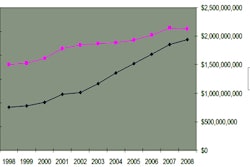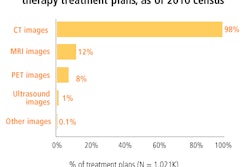High-dose intensity-modulated radiation therapy (IMRT) and prostate brachytherapy have been considered to produce equally excellent survival outcomes for men diagnosed with low-risk localized prostate cancer. But a new study published online December 31 in Urology challenges this assumption.
Prostate brachytherapy seems to be the better treatment option for most men diagnosed with low-risk prostate cancer. Compared to IMRT, brachytherapy offers 5% to 10% better biochemical control rates, takes twice as long to reach nadir prostate-specific antigen (PSA) values that are lower than those of patients undergoing radiation therapy, and offers a better chance of patients not becoming sexually impotent.
These are practice-changing findings for physicians at Memorial Sloan-Kettering Cancer Center in New York City, who now favor brachytherapy as the treatment of choice for patients who have the option of either therapy, according to lead author Michael Zelefsky, MD, radiation oncologist and chief of brachytherapy service, and colleagues.
In the study, the researchers compared biochemical tumor control, survivor outcomes, and the incidence of late toxicity in 448 men who received low-dose permanent interstitial iodine-125 (I-125) and 281 men who had IMRT treatments at Memorial Sloan-Kettering. All patients had low-risk localized prostate cancer, with clinical stage T1-T2a, a Gleason score of 6 or less, and a pretreatment PSA level of less than 10 ng/mL. The men underwent treatment between 1993 and 2003 and made their own decisions regarding which treatment to receive.
Seven-year outcomes revealed that men who underwent prostate brachytherapy achieved a 95% PSA relapse-free survival rate, compared with an 89% rate for men who had high-dose intensity-modulated electron-beam radiation therapy.
The men who underwent prostate brachytherapy had I-125 monotherapy to a prescribed dose of 144 Gy. The median volume of the prostate receiving 100% of the prescription dose was 96%, and the median dose to 90% of the prostate was 170 Gy. Thirty-one percent of the patients in this group had a gland size greater than 50 cm3 and received a 90-day course of androgen deprivation therapy to decrease prostate volume.
Men who had IMRT received daily fractions of 1.8 Gy to a prescription dose of 81 Gy. The planning target volume receiving 95% or more of the prescription dose was 90% or greater. Thirty-two percent of this group also received a 90-day course of androgen deprivation therapy.
Brachytherapy also proved to be superior to IMRT for men who did not need androgen deprivation therapy. For this subgroup, the brachytherapy treatment group had a median nadir PSA value of 0.1 ng/mL, compared with a value of 0.6 ng/mL for the radiation therapy group. For the total group, the interval to reach PSA nadir was almost twice as long for men who received brachytherapy: 43 months compared to 23.5 months.
Fewer brachytherapy patients developed post-treatment impotency. More than 75% of the men who chose this treatment had stated that they were potent. Only 35% subsequently experienced erectile dysfunction. Of the 66% of men in the IMRT group who had stated they were potent, almost half (44%) became impotent.
Because the two groups were of similar age, age was not considered to be a contributing factor. However, the authors cautioned that because of a number of variables, it is difficult for them to state with certainty that prostate brachytherapy represents a significant advantage in preserving sexual potency.
There was one major trade-off: Toxicities were higher for the brachytherapy group. The incidence of grade 2 late urinary toxicity was almost four times higher, at 15.6%, compared with 4.3% for the IMRT group, and 5.1% developed rectal bleeding, compared with 1.4% of the IMRT group.
Five patients in the brachytherapy group developed grade 3 gastrointestinal late toxicities; none did in the IMRT group. Ten patients receiving brachytherapy developed grade 3 genitourinary late toxicities, compared with four IMRT patients.
There also was no statistically significant difference in metastasis-free survival between the two groups.
The authors suggested that prostate brachytherapy improves biochemical control outcome because greater biologic doses can be delivered safely to the tumor. But they observed that it was impossible to prevent significant portions of the prostate from receiving doses greater than 250 Gy. This was also the reason that both genitourinary and gastrointestinal late toxicities were higher.
For patients who have comorbidities or conditions in which the risk of a higher level of late toxicities seems likely, IMRT remains the treatment of choice. But for many patients and their physicians, this study may help their decision-making process.
By Cynthia E. Keen
AuntMinnie.com staff writer
January 18, 2011
Related Reading
Brachytherapy good option for younger prostate cancer patients, December 9, 2010
Positive results reported with stereotactic RT for prostate cancer, November 23, 2010
Tumor tracking for prostate IMRT reduces GI side effects, March 26, 2010
CyberKnife benefits prostate cancer patients, October 1, 2009
Prostate brachytherapy side effects self resolve, September 11, 2009
Copyright © 2011 AuntMinnie.com



















